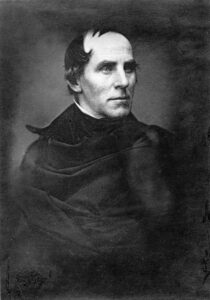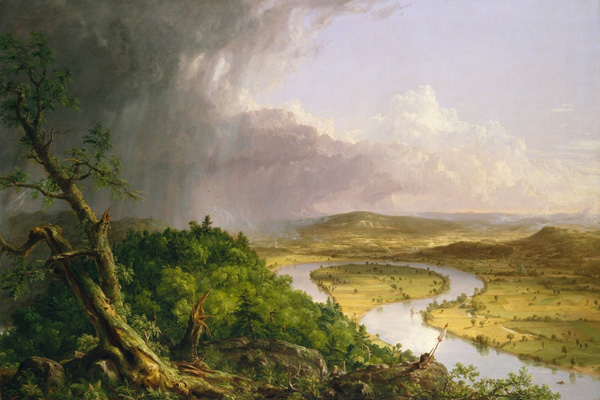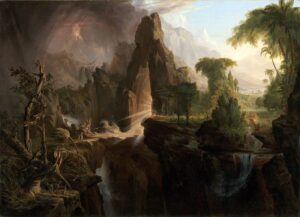Brother Thomas Cole of Amity Lodge No. 5 was raised into our fraternity by the Masons of Ohio. He was an American artist, early environmentalist, and the founder of this nation’s first significant art movement, now known as the Hudson River School of landscape painting.

Portrait of painter and Freemason Thomas Cole
The Young Artist
British by birth, Thomas Cole was born in Bolton le Moors, Lancashire, England, in 1801. His family emigrated to the United States in 1818, first to Philadelphia and then onto Steubenville, Ohio, where they settled. Cole worked as an engraver while feeding his early interest in painting, teaching himself and honing his skills as a portraitist before becoming a student of a painter named Stein.
Under Stein’s tutelage, he made modest earnings painting portraits before returning to Philadelphia at age 22. He studied at the Pennsylvania Academy of the Fine Arts, completing several pieces that earned him a spot within the Academy’s exhibits.
Changing Focus
In 1825, Cole moved to New York City and began establishing roots in the cultural community. He soon took a life-changing trip up the Hudson River to the Catskills, becoming fascinated with the melancholy scenery. He sketched scenes along the river, which he translated into paintings, and was so moved by the experience that he shifted his painting towards landscapes.
His three paintings were displayed in the window of a city bookseller when Colonel John Trumbull, a renowned painter of the American Revolution saw and instantly purchased one. He pointed his colleagues William Dunlap and Asher B. Durand to the remaining two, and the trio immediately recognized Cole’s innate gift for capturing the American wilderness. They introduced Cole to several patrons who were captivated by his work. So moved were they by his scenic illustrations that Dunlap promoted Cole publicly, ushering Cole into New York’s cultural community. To cap off a great year, Cole helped found the National Academy of Design in 1825.

The Oxbow (1836) is on display at the Metropolitan Museum of Art
The Catskills and Beyond
With his profile on the rise, Cole settled in the village of Catskill, New York, on the western bank of the Hudson River. Here he could be closer to the environment he cherished while enjoying convenient proximity to the rest of the Northeastern United States. He began journeying through New York and New England, studying the landscape and crafting pencil sketches that he transformed into paintings at home during the winter.
Over the next few years, Thomas began incorporating biblical and literary subjects into his images, including the famous American epic, Last of the Mohicans. He composed magnificent and dramatic natural scenes, effectively using light and chiaroscuro to capture the world’s colors. Human figures were humbled amidst his majestic landscapes, emphasizing man’s small role within the greater universe.
By 1829, his paintings had earned him international notoriety. That year he returned to England to check in on his family’s business, European buyers were eager to commission Cole. He soon embarked on a tour of the continent, particularly enjoying extensive visits to Italy and painting many subjects of the region. Famously, he captured an ancient aqueduct in his A View near Tivoli (Morning) and created an homage to ancient Greek mythology in Titan’s Goblet.
The Course of Empire
Upon Thomas Cole’s return to New York in 1832, he exhibited his European paintings to much acclaim. Luman Reed, a local merchant and art enthusiast, took an interest in Cole and his work, becoming one of his most important patrons. For Reed’s collection, Cole created what is perhaps his best-known series of paintings: The Course of Empire.
The series consisted of five paintings depicting the rise and fall of an imaginary city and reflected Cole’s mounting concern over the rapid industrialization of his beloved Catskills. He saw the expanding railroad system particularly having a direct negative impact on the area, threatening the serene yet haunting beauty of the Catskills, which inspired his works.
Due to Cole’s fame, The Course of Empire became a topic of national discussion. His vocal opposition to industrialization was controversial enough that Levi Woodbury, a Democrat and a justice of the United States Supreme Court, wrote to Cole to quell his concern, remarking that there would be no destruction in the United States.
1836 was eventful; Cole’s father and Luman Reed passed away, and Cole married Maria Bartow. Together they raised five children in the village of Catskill, where their daughter, Emily became an artist of porcelain and watercolor. Over the next decade, Cole remained immensely popular, and his environmentalist views became increasingly influential. As he and Maria raised their family, he journeyed more deeply into his faith and reflected his piety through his work. A famous example is The Voyage of Life which shows a river journey representing the human passage through life to eternal reward.

Expulsion from the Garden of Eden (1828), Museum of Fine Arts, Boston
By the late 1840s, Cole was creating his most ambitious series, The Cross and the World but sadly passed away before completing the work. After contracting pleurisy in February 1848 on his way home from morning service at Saint Luke’s Episcopal Church in Catskill, his condition deteriorated rapidly, and he died a few days later.
Hudson River School & The Masonic Legacy
Inspired by Cole, dozens of romantic painters in the mid-19th century began executing his aesthetic vision, painting landscapes across the Hudson River Valley, the White Mountains of New Hampshire, and the Adirondacks of New York. They became known as the Hudson River School and even expanded to the American West and South America during its second generation. Like Cole, these artists view modern economic and technological development with some suspicion. Through his passion for the environment and breathtaking scenes, Cole continues inspiring artists to this day.
In his honor, the fourth highest peak in the Catskills is named Thomas Cole Mountain. His old studio at Cedar Grove is today known as the Thomas Cole House and was declared a National Historic Site in 1999. And while the details of his Masonic journey are not well-known, fraternal records indicate that Cole was a member of Amity Lodge No. 5, Zanesville, Ohio. An excerpt from, “The History of Lodge of Amity, No. 5” published in 1879 recounts, “June 28th, in a class of five initiated as Entered Apprentices was the afterwards celebrated Thomas Cole, the painter of the “Course of Empire, ” the “ Voyage of Life, ” etc. and of whom William Cullen Bryant said, in his funeral oration: “had a fixed reputation and was numbered among the men of whom our country has reason to be proud.” Another in speaking of him, says: “His life was one of singular purity, and in the latter part of it he manifested a sincere and unostentatious piety. His poetic feeling, so amply illustrated in his works, frequently found expression in rhythmic form and his miscellaneous papers in prose and verse, few of which were ever made public, possess considerable literary merit.” He painted the first Masonic Carpet that adorned the new Lodge room in Zanesville, and for a time had numerous orders at Zanesville. Bro. John D. Caldwell has a portrait of himself by Bro. Cole, and in the boy of six years, with prayer book under his arm and dog by his side the present Grand Secretary would not be recognized.” Brother Thomas Cole will always be remembered as a visionary and as a historical figure in Freemasonry.
Is there a famous Mason from your lodge you’d like to see featured? Email OhioLodgeLife@Freemason.com!